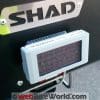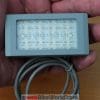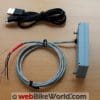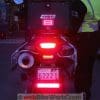The Ohmics brake light is a palm-sized module with integrated sensors and a microprocessor.
It has a bright eye-catching 40-LED output screen and it is programmable by the owner to display various LED light patterns.
The user-definable programs include different light patterns for deceleration and braking or brake or deceleration-only modes.
When the motorcycle slows due to throttle action or engine braking or downshifting or any combination thereof, the reduction in speed or deceleration is measured by the Ohmics system.
The light will then display an early and very conspicuous three-stage LED output sequence proportional to the deceleration and speed of the motorcycle.
This allows the rider to maintain a safer riding environment by providing an early and very conspicuous warning or reactive notification to following traffic of the motorcycle’s slowing.
All of this is done without brake activation.
When the brakes are engaged, the Ohmics light instantly switches to brake mode.
This provides a warning flash followed by a programmed output sequence.
And if turned on during programming, a distinctive horizontal centre row of white LEDs blink twice every 0.5 seconds (at 20Hz) providing an excellent marker especially at a stop.
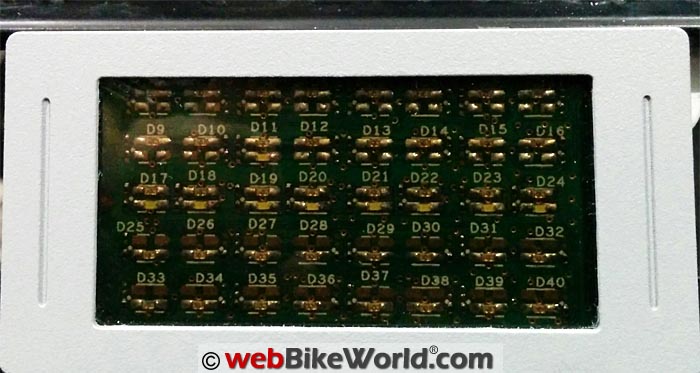
Background
An “intelligent” brake light?
Yes — and just an early sign of what is coming to market.
Calling it a “motobrake” light doesn’t tell the whole story, as it does a lot more…for you as the rider and for traffic following behind.
And to use an expression that will be familiar to many: it really does protect your “six”.
The key focus of the self-contained Ohmics Intelligent MotoBrake Light is to function as a deceleration sense and warning light for motorcycle application, although its design and functionality makes it useable on almost anything that moves in a forward manner.
That includes walking, cycling or powered vehicles, regardless of whether the platform has a braking capability or not.
We had early access to the Ohmics Intelligent MotoBrake Light for testing and daily use on several motorcycles in different configurations.
It has proven itself to be a reliable, evolvable and effective solution to expanding a rider’s safety envelope well beyond the motorcycle.
Bottom line: think “small footprint but huge presence” and a positive factor regarding traffic safety.
Editor’s Note
It’s important to note that currently there are no recognized standards for brake light modulation that we are aware of and very few — if any — formal studies to understand how traffic will react to anything other than the standard off/on brake light.
For example, it is possible that the driver of a vehicle behind a motorcycle using a non-standard brake light accessory may become confused when the lights start to pulse, which could actually decrease their reaction times.
There are also no standards for brake light modulation during deceleration, so traffic behind the motorcycle may not understand the meaning of those lights either.
Further, non-standard rear (or front) lighting systems may not be legal in some jurisdictions. Bottom line? Use with caution.
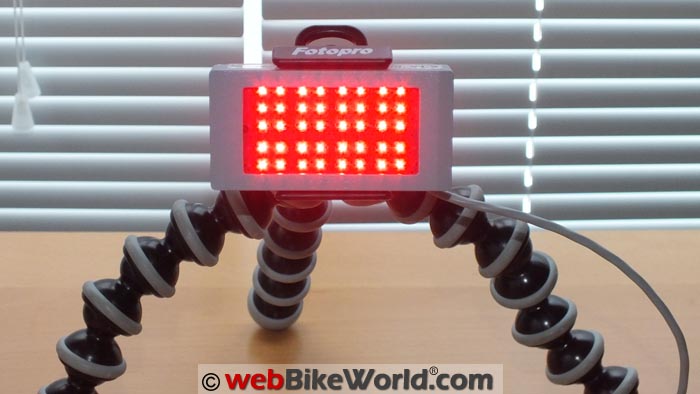
Introduction
Following or being followed by another vehicle serves to showcase just what a deceleration or inertia-based rear facing light can do in providing an early warning to the fact that the motorcycle is slowing.
When a motorcyclist approaches a curve, off-ramp, turn or whatever the rider (may) reduce speed.
This is caused by rolling off the throttle to let natural and engine forces slow the motorcycle or by a shift into a lower gear.
To carry out a smooth progressive combination of both, all without using the brakes, is a skill that many of us practise and actions that many of us do without touching the brakes.
Since the brakes may not be activated in those situations, neither is the brake light.
And unless following traffic is very observant, the reduction in speed by the motorcycle can create a hazardous situation, especially if the following traffic is tailgating or overtaking rapidly.
This situation is exactly why motorcyclists under training are taught to lightly touch the brakes when slowing or preparing to slow, just enough to trigger the brake light providing a visual and again, an early warning of sorts.
Despite our knowledge, education, training and experience however, many of us don’t make this effort, for all sorts of reasons.
But right or wrong, in traffic this inaction can create a scenario that none of us like facing. But never fear, technology is here and innovative solutions based on acceleration/deceleration principles have arrived or are being developed, often by avid motorcyclists.
Examples are the Vololight Brakeless Deceleration Indicator, which we hope to evaluate soon was seemingly the first installable system to market with others pending, like the StopTix automatic brake light.
All of these products take different forms and use different fitment approaches. Some provide mounting options; others do not.
But they all do provide an inertial or deceleration-based sensor capability so that when a motorcycle slows for whatever reason, a visual output warning is provided to following traffic.
The Clearwater Lights CANopener (review) identified that this capability is also being implemented, confirmed by the just released “Billie Brake” that can provide inertia-based brake-mode output from its LED bank (CANopener version 1.8+ required).
We will be completing a follow-on review of the Billie Brake and all its feature very soon.
So while not the first to market, we now have what is arguably the most innovative, evolvable and versatile entry to this safety-related segment: the Ohmics Intelligent MotoBrake Light, which is in production and available for sale.
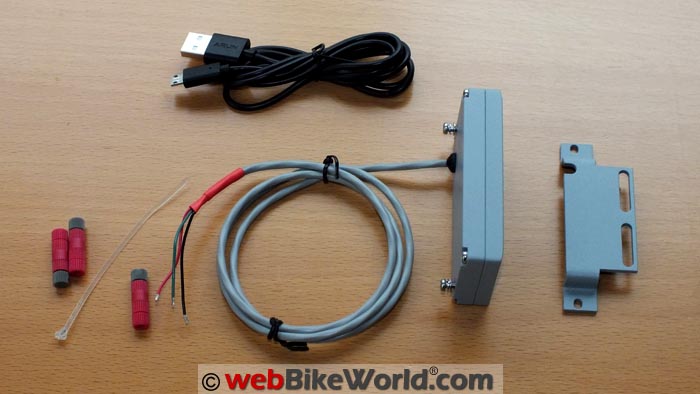
The Ohmics “Intelligent” Brake Light
Conceived, developed and brought to market by an engineer and motorcycling enthusiast living in Ottawa, Canada, the Ohmics Intelligent MotoBrake Light is the first of several (really useful) powersports products being developed. The focus on the brake light is motorcycles, of course.
Measuring 80 x 40 x 15 mm (3.025 x 1 5/8 x 0.50 in), the palm-sized aluminum powder-coated module is easy to mount and connect.
The system senses and measures deceleration and based on the measured deceleration, a progressive three-step LED output sequence is generated by a 40-LED matrix screen.
This warns following traffic of the deceleration of the motorcycle, without requiring the use of the brakes. And when the brakes are applied, the default or programmed brake output pattern is displayed.
And as part of brake mode, an eye-catching centre row or bar of white LEDs pulses at a frequency that is hard to miss, particularly in slow-moving or stopped traffic conditions.
While not the first device of its type, the Ohmics MotoBrake Light is unique in several ways.
Its small weatherproof form factor provides flexibility in fitment. It is easy to mount and connect using the small bracket and simple three-wire harness and the 40-LED matrix features a high output.
But the most unique aspect of the Ohmics light may be its ability to be programmed by the owner to display various LED deceleration and brake output patterns.
The Ohmics light system is pre-programmed with distinctive LED output patterns for deceleration and brake modes, but the user has control over all configurable features.
The LED light has three functional modes: deceleration, brake or deceleration/brake combined. The white LED row or bar marker can be configured for on or off and a micro-USB interface provides connectivity for user-based output programming and firmware updates.
The user-definable programming includes multiple deceleration and brake output options, sensitivity adjustment based on the platform, selection of operational mode and activation or deactivation of the horizontal white LED flashing marker bar.
There are three modes of operation (video demonstrations available on the Ohmics website):
- Mixed: deceleration and/or brake activated;
- Brake Activation Only: the accelerometer is disabled;
- Deceleration Only: for applications where a brake light connection cannot be made (such as when used on a bicycle.)
And if a power supply is needed, a small inexpensive micro-USB based portable charging cell works perfectly. The Ohmics Intelligent MotoBrake Light provides a lot of versatility for the investment.
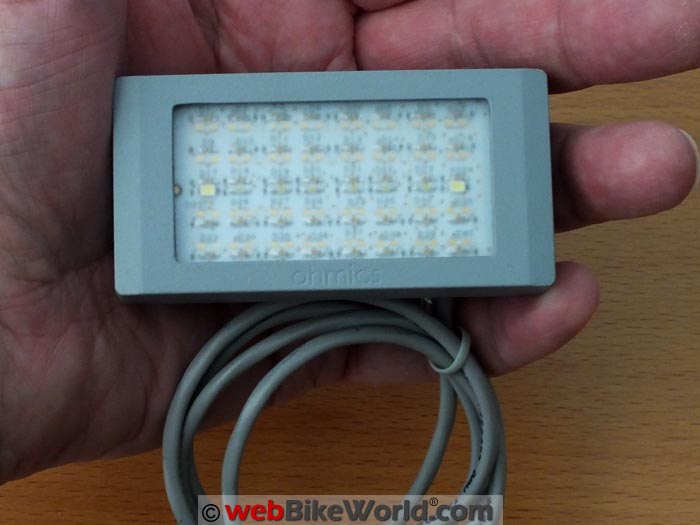
Specifications
Basic Specifications of the Ohmics MotoBrake Light include:
- Input Power: 4.5 to 40VDC, max 150mA at 12V.
- Brake input: up to 15V LED Matrix Brightness.
- 1800 millicandela (mcd)/LED.
- Centre Line White LED Brightness: 1395mcd/LED.
- Centre Line LED Pulsing: every 500ms (0.5 sec) @ 20Hz.
- Accelerometer Sensitivity Levels (gravitational-force).
- Low: 0.16 – 0.53g
- Medium: 0.13 – 0.30g
- High: 0.06 – 0.26g
- Environmental:
- Operation: -20C to plus 50C (-4 to 122F).
- Storage: -40C to plus 55C (-40 to 131F).
- Dust and water resistant (when USB cap in use).
In the Kit
The Ohmics MotoBrake Light kit includes the brake light module; a micro-USB 2.0 interface cable; three standard Red/Gray Posi-Tap connectors; one micro-USB recess dust cap (don’t lose it!); a mini earth magnet (don’t lose this either); the universal mounting bracket and M3/M4 screws for the universal mounting bracket.

Programming the Ohmics Brake Light
As noted, the Ohmics Intelligent MotoBrake Light is pre-configured for delivery but the option to install the GUI-based “Pattern Designer” and firmware upgrade applications is also available to just learn and play.
Everything needed is listed at and available for download from the Ohmics website. For MS Windows environments, Win 7 (SP1) and above is supported, although depending on any specific PC environment, some fine tuning might be needed.
This is all explained in the User’s Manual and related documentation.
Win 8.1 users will typically need to do some additional downloading and undertake some configuration tasks to get the needed environment in place.
Support for Mac and Apple platforms is planned, as well as an Android-based environment down the road. And I’m still working on the Windows Technical Preview (aka Windows 10) configuration — one step forward, sometimes one step back, etc… but it is getting there.
MotoBrake Programming
The Pattern Designer LED programming application can be used to configure the Ohmics Intelligent MotoBrake Light by programming the 40-LED (8 x 5 line) matrix with desired patterns and motions through interactive design.
All configuration settings are done using this application as well — like selecting the operational mode (mixed, brake plus accelerometer or just brake activated).
By default, the unit has the accelerometer activated (Deceleration Mode). Sensitivity levels of high, medium or low can also be selected depending on the platform/use. The centre white LED bar output can be turned on and off as well.
Other configuration features have and are being added through firmware updates.
Remember that “evolvable” point? There is a lot of flexibility — up to 18 output patterns for Brake Mode and for Deceleration Mode up to six motions each with three successive patterns that correspond to how hard the vehicle decelerates (this adds up to 18 as well, hmmm).
For simple programming visualization of the desired patterns for each mode, using sheets of graph paper with multiple 8 x 5 tables (40 squares) laid out works, as does a spreadsheet template.
This approach facilitates design and programming of any or all of the available memory bins for use, while providing a record of what was done.
The User’s Manual provides a step-by-step approach with examples of both Deceleration and Braking Mode programming so only the basics are covered here.
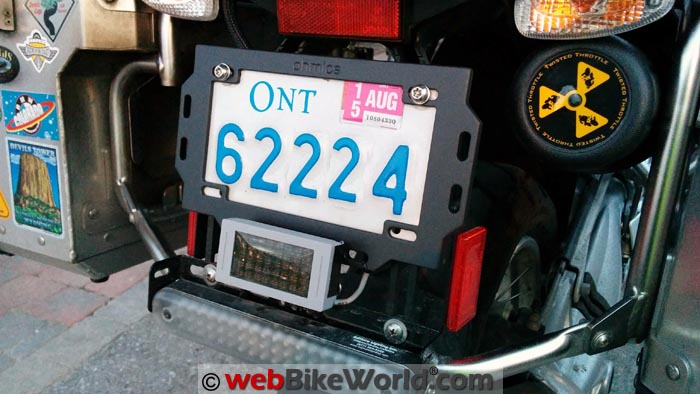
Programming Tips
Deceleration Mode: In programming any of the six (0 to 5) indexes or motions, remember that each motion is actually an output sequence consisting of three levels (Level 0, 1 and 2) or steps. Each provides the progressive “motion” effect when activated.
As such, a good approach is to design a succession motion that when activated in response to how hard the vehicle decelerates, displays a motion or sequence that builds from Level 0 through Level 1 to Level 2 as output.
Think of a building-block approach, in that each successive level builds or evolves from the previous one.
Brake Mode: While designing and programming for brake mode is simpler than working through the deceleration mode programming, the user does have the ability to store up to 18 patterns at a time.
Firmware Upgrades
The latest released firmware will be installed on delivered modules, but tweaking and enhancements have and will continue to be made and the user has the ability to update the firmware or not.
The current firmware version is displayed at the bottom of the Pattern Designer screen, along with other device information. And take comfort in the fact that doing a firmware update will NOT erase the stored patterns or motions nor change the last configured settings.
To update the firmware follow the detailed instructions in the User Manual (Section 3.3) and don’t forget that this is why the magnet is part of the kit.
Mounting Considerations
The Ohmics brake light module is meant to be mounted horizontally (lengthwise) on the motorcycle, with the LED matrix facing to the rear (of course).
Otherwise, the accelerometer functions will/may not work properly.
Orienting it so the LED number markings are readable left to right keeps orientation correct. An ideal location for the module is on or around the license plate frame or if other accessory brackets are mounted, above, below or to the side. As long as the required orientation is maintained all should be well.
I tested two modules mounted vertically, which didn’t result in any degradation of performance; they were installed on the left and right side lobes of the prototype Ohmics License Plate Frame (now in production).
One module had the original (now optional) translucent screen and the other the now standard tint screen (current tint is lighter than shown in photo below).
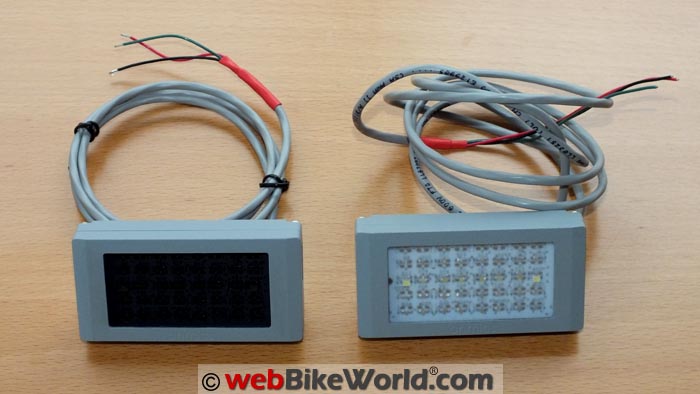
Installing the Ohmics Brake Light
Mounting the module and bracket combination is generally simple, although some preparation may be needed to find the best mounting point and template the holes needed for the small bracket.
I have installed Ohmics brake light modules on four different motorcycles. Two used generic license frame brackets subsequently drilled to accept the small Ohmics bracket; the other two fitments were easier by using the back slotted brackets of the Admore Lighting light bars installed on the these motorcycles.
When using the provided stainless steel M4/M3 Phillips or Torx screws, a drop of thread locking compound is recommended due to possible vibration.
I actually swapped the provided screws out for stainless steel socket head cap screws.
Wiring the MotoBrake Light (may) take less time than mounting it. The provided Posi-Tap connectors should make short work of connecting the Red (tail/power), Green (brake) and Black (ground) wires to the respective OE wires.
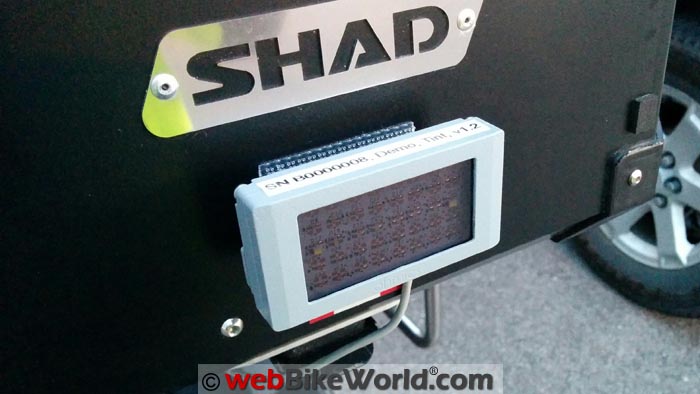
BMW CAN Bus Notes
I have tried the Ohmics MotoBrake Light successfully with newer (2013+) as well as older Beemers. But if the CAN bus alarms or trips the circuit when the Ohmics harness is connected, a separate 12V switched supply lead for the Red wire is needed; this being one of the best solutions to overcome accessory issues.
And for the often pesky brake pulse issue (pulsing signal on the wire and 12V applied only when brake is activated), the on-board hardware and software has built-in compensation that addresses known and (potential) issues to mitigate this scenario.
Second tip (caution): the Ohmics MotoBrake Light performs a self-calibration sequence when powered up the first time.
This turns on the complete LED matrix for up to five seconds and like most modern LED units the singular or cumulative light emitted is extremely bright and can cause eye injury by direct close viewing. Please exercise caution during installation and operation.
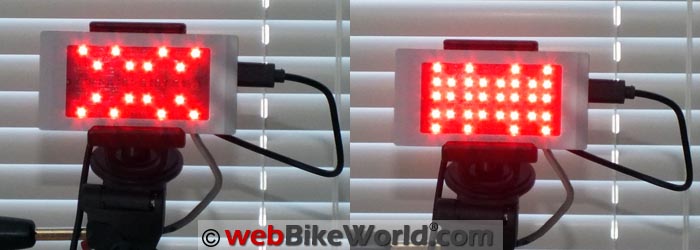
Function and Performance
The Ohmics Intelligent MotoBrake Light has a 40 LED matrix with patterns and motions as configured by the user using a programming process on an interactive basis.
Operational modes are Mixed Mode (deceleration and brake); Brake Mode; and Deceleration Mode.
Up to 18 patterns can be stored in the flash memory in brake mode operation, of which only one can be selected for operation at a time.
Similarly up to six motions, each containing three patterns corresponding to how hard the vehicle decelerates can be stored in accelerometer mode.
The unit can be configured to work in any of the three modes depending on the installation and riding environment. Setting up the application environment and programming of the unit was covered in the preceding Software Environment section.
Mode 1 (Mixed Mode): In this mode, the unit activates the LED matrix if the vehicle decelerates. Based on the level of deceleration, the LED matrix displays a succession of three LED patterns forming a visual pattern or motion in direct proportion with the deceleration.
If at any time the brakes are activated, the accelerometer is automatically disabled during braking.
When the unit enters Brake Mode operation, the full matrix flashes for 0.5 seconds following by the programmed brake pattern. Simultaneously, if so activated, the centre white line blinks twice every 0.5 seconds (at 20Hz frequency) for higher visibility (conspicuity).
Mode 2 (Brake Mode): In this mode, the accelerometer can be or is disabled during system configuration. When the brakes are activated, the LED activates as described above in Mixed Mode, with or without the centre line White LED output (as configured).
Mode 3 (Deceleration Mode): A vehicle-specific mode where a brake circuit may not be installed such as a bicycle or some off-road motorcycles.
As such, the system relies on the accelerometer to determine when the vehicle decelerates and if so the LED matrix is activated. The matrix turns off once deceleration ceases.
This mode, along with activation of the centre horizontal white LED marker bar and a compatible portable power source attached provides a very visible marker day or night.
And of course, it also shows deceleration output (more information is available on the Ohmics website).
On a day-to-day basis, Mixed Mode is the default configuration, so that the LED matrix activates when the deceleration parameters are met and when the brake or brakes are activated, even lightly for trail braking purposes.
It is comforting to know that a very visible deceleration warning is being projected to following traffic.
With spring in full swing and with lots of riding, fellow road users, including cyclists, have commented on or asked about the very obvious deceleration-based output.
They have also commented on the intensity of the additional brake light and how eye-catching the centre white LED line is especially in low light or nighttime conditions.
And when fellow motorcyclists ask about the small module installed on the back, currently just below the license plate or on the back of the top box/top case, the conversation tends to get a bit extended but always interesting and always positive.
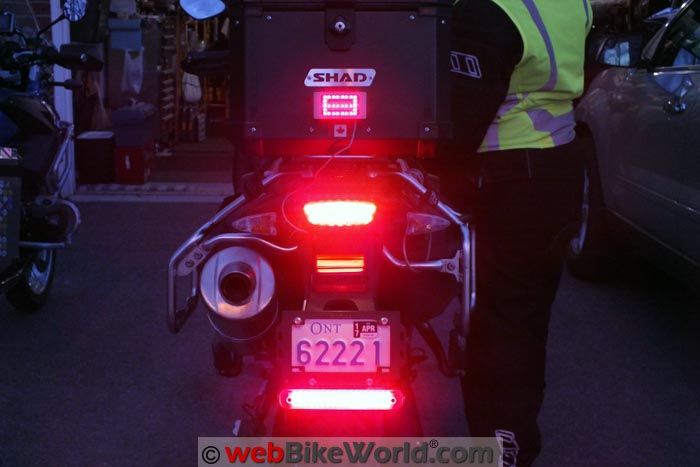
Conclusion
Exposure to and use of the Ohmics Intelligent MotoBrake Light served to confirm a lot of premises accumulated over a few decades of riding.
And as a former long-time motorcycle safety trainer and participant in road and off-road events, the requirement for a capability like the MotoBrake was and is recognized. Thankfully it has now come to fruition.
And in being brutally honest, it isn’t getting any better (safer) out there on two wheels and most days it seems we need all the help available to just survive one trip at a time.
Thankfully for most riders, a regime of education, regular training (refresher or otherwise), experience and attitude keeps the wheels turning.
The technologies used on modern motorcycles, with their “smarts” coming in varying form and function enhance performance and safety.
Accessories like front facing auxiliary lighting, rear facing augmentation tail and brake lights or of course more recent innovations such as inertia or deceleration-based brake products add even more positives to the riding package.
But, we also need to be cognizant of the fact, or facts, that this newest addition to the safety envelope tool box won’t be accepted by everyone and if it hasn’t yet attracted the attention of lawmakers, it soon will.
Education and industry support along with sensible application and use will be key in promoting and gaining acceptance for this type of device. Also, testing and standards will be required to help bring these types of “intelligent” brake lights into the legal mainstream.
It is (currently) hard to get a (good) sense of just how much studying of the related technologies and potential application is being done by government or industry, although the technology has been or is being considered for other power-sports applications.
Stay tuned, this whole segment is going to get a lot more interesting…
So while the Ohmics Intelligent Motobrake Light is not the first product of its kind to market it is unique in many ways and it is an outstanding example of what can be done by leveraging knowledge, experience, ability, technology and or course, desire.
Result – a deceleration and braking device that significantly expands the safety envelope of rider and machine and concurrently that of following traffic.
Investing in this type of product is not a bad thing and it may even save a few lives.
UPDATE: Ohmics MotoBrakeBT Bluetooth Brake Light Review
Owner Comments and Feedback
See details on submitting comments.
From “H.S.” (June 2015): “I installed Bright Ass brake lights on my Harley. I programmed them to flash 3 times when I apply the brake and then to stay on like a regular brake light. I have noticed that following traffic stops and slows much farther behind me since I installed the lights so apparently drivers are not confused.”
From “P.L.” (May 2015): “Thank you for the review of the Ohmics thingy. I’ve been looking for a similar system for quite some time, and I’d rather see a system that just uses the existing brake light.
I actually had a SMIDSY Hazard Flasher. But I never could get it to work properly on my V-Strom 650. And now I have a Tiger 800 XC with even more suspension travel.
Could you tell me which similar devices you intend to test (and by when), and perhaps tell also a little more about the ‘new developments in the area’ you hint about? Not that I am curious, of course…
P.S.: I recently also had a conversation with KTM about deceleration braking lights and they said: ‘Turning on brake lights in case of hard engine braking to avoid tail-collisions is a feature that we’ve already developed some years ago.
This feature is quite similar to the so called ‘ESS – Emergency Stop Signal’ which makes itself felt as a flashing brake light when braking hardly. The problem on both systems is that they are not legal at the moment due to EU regulations.’ ”




